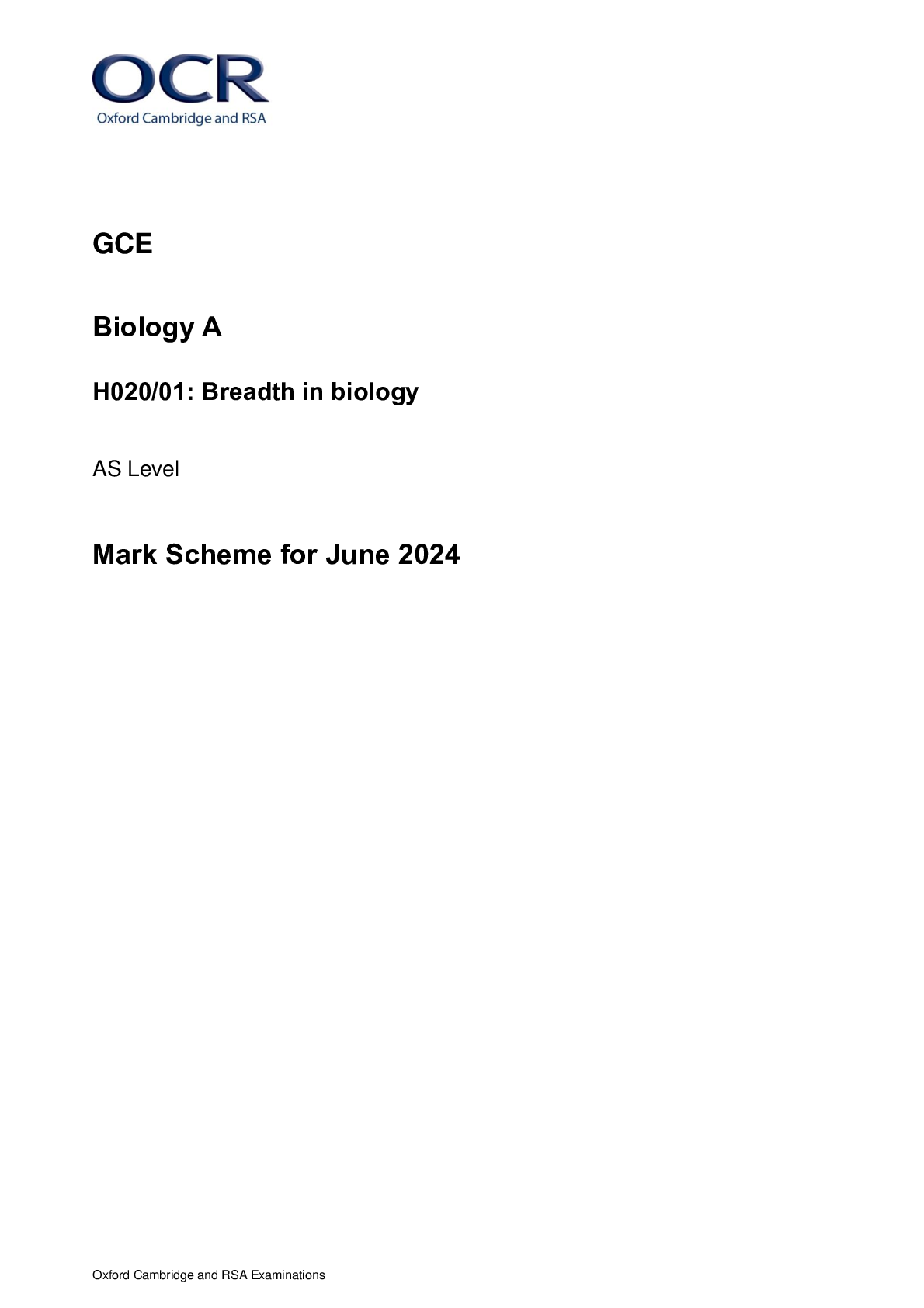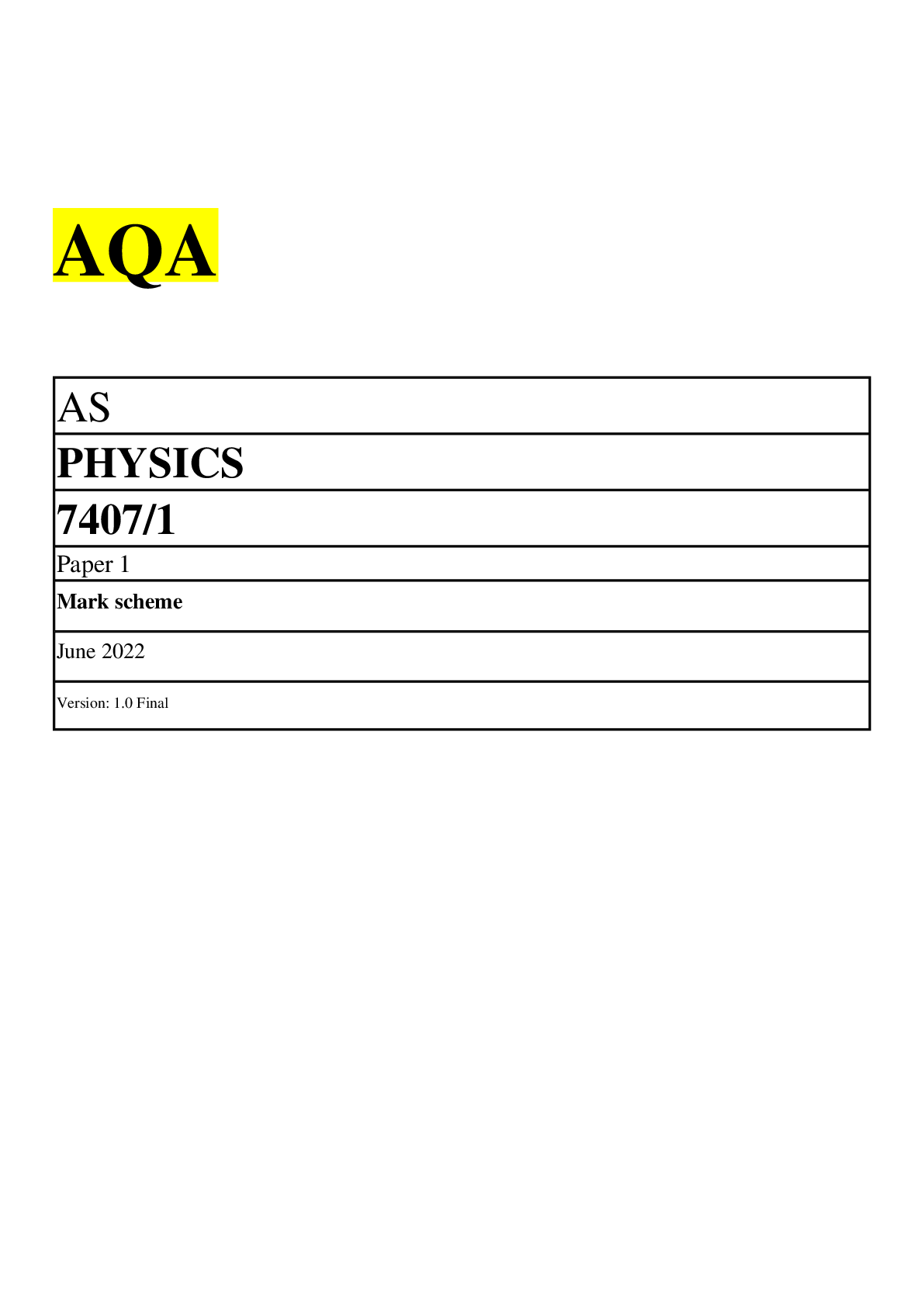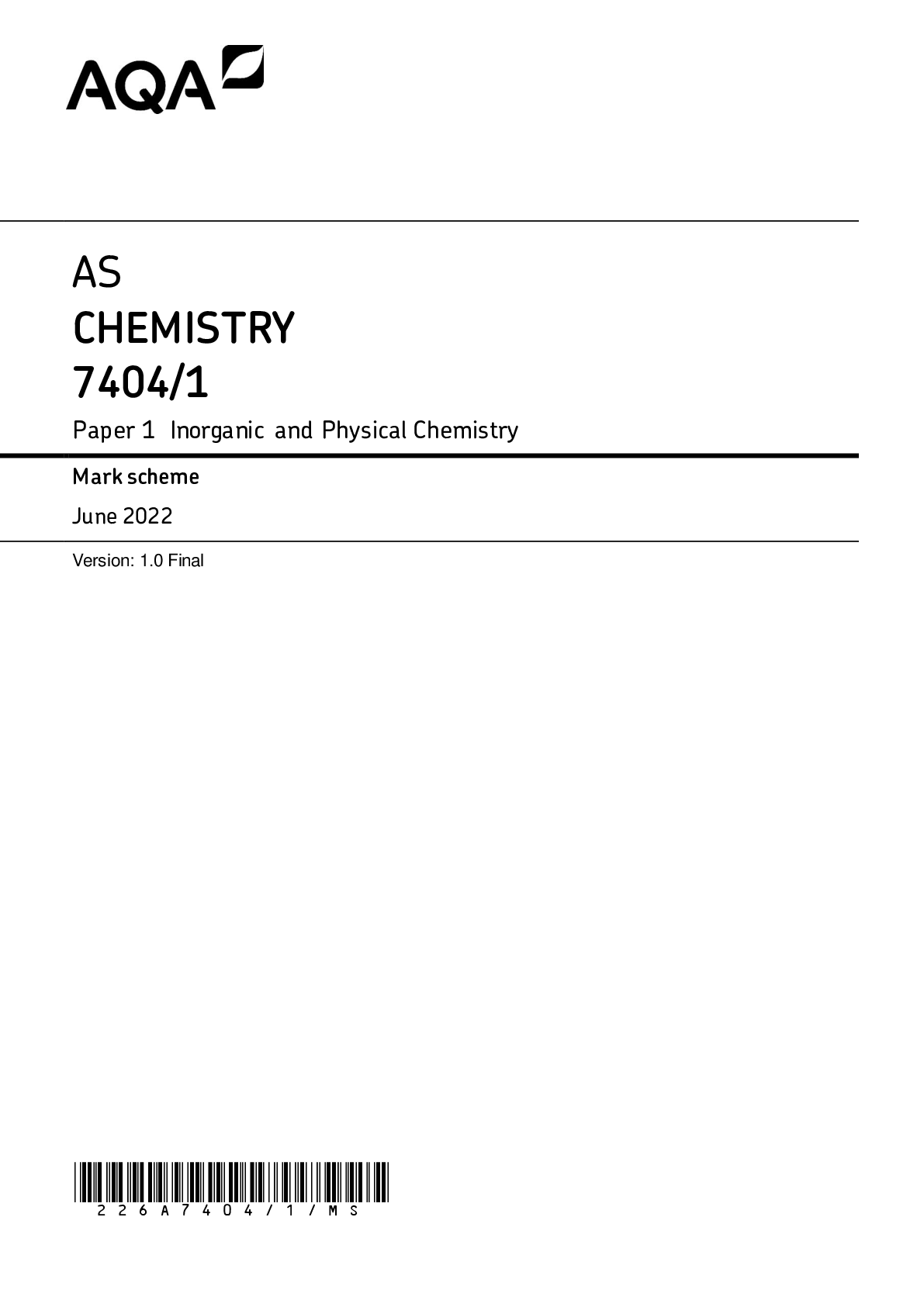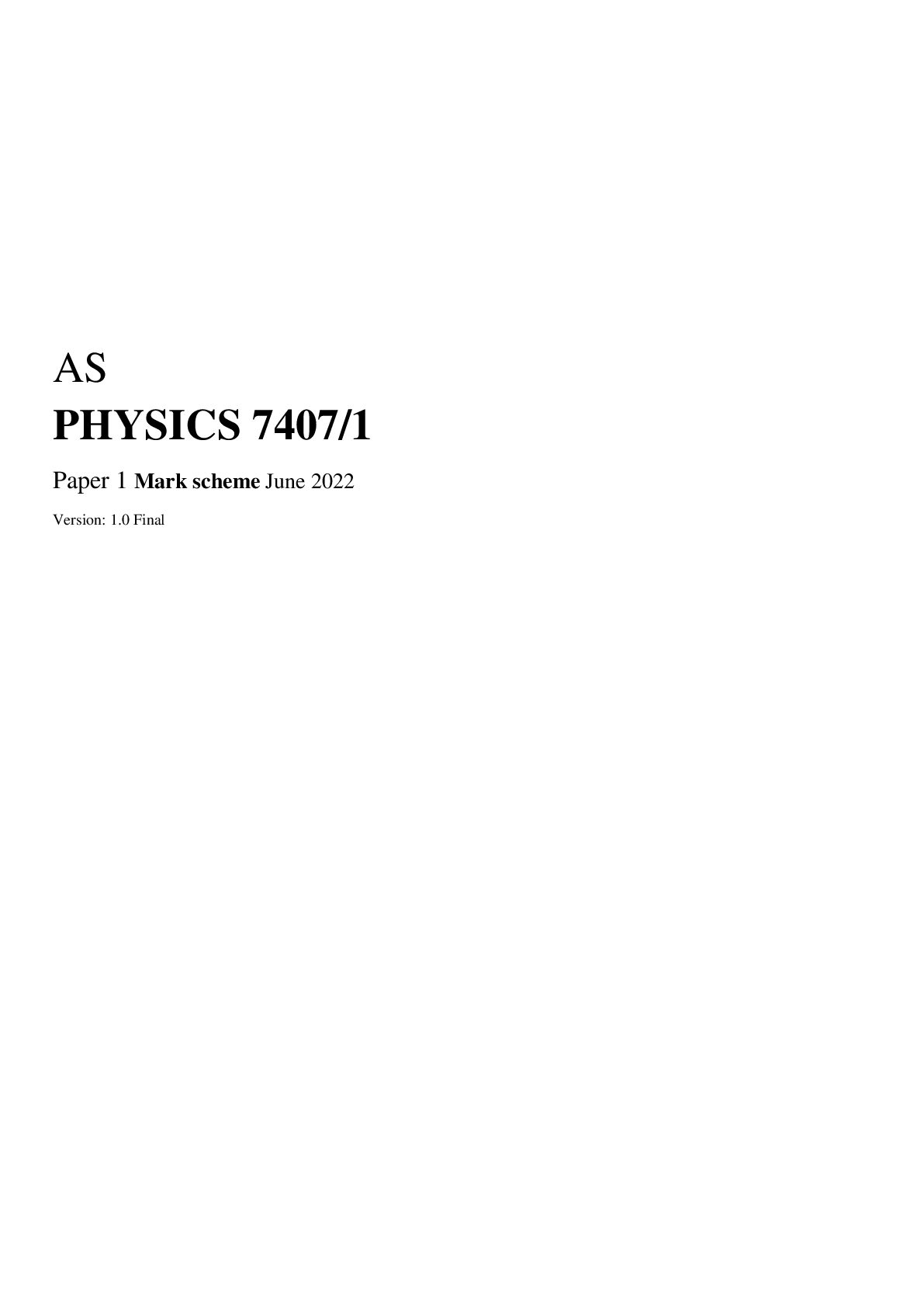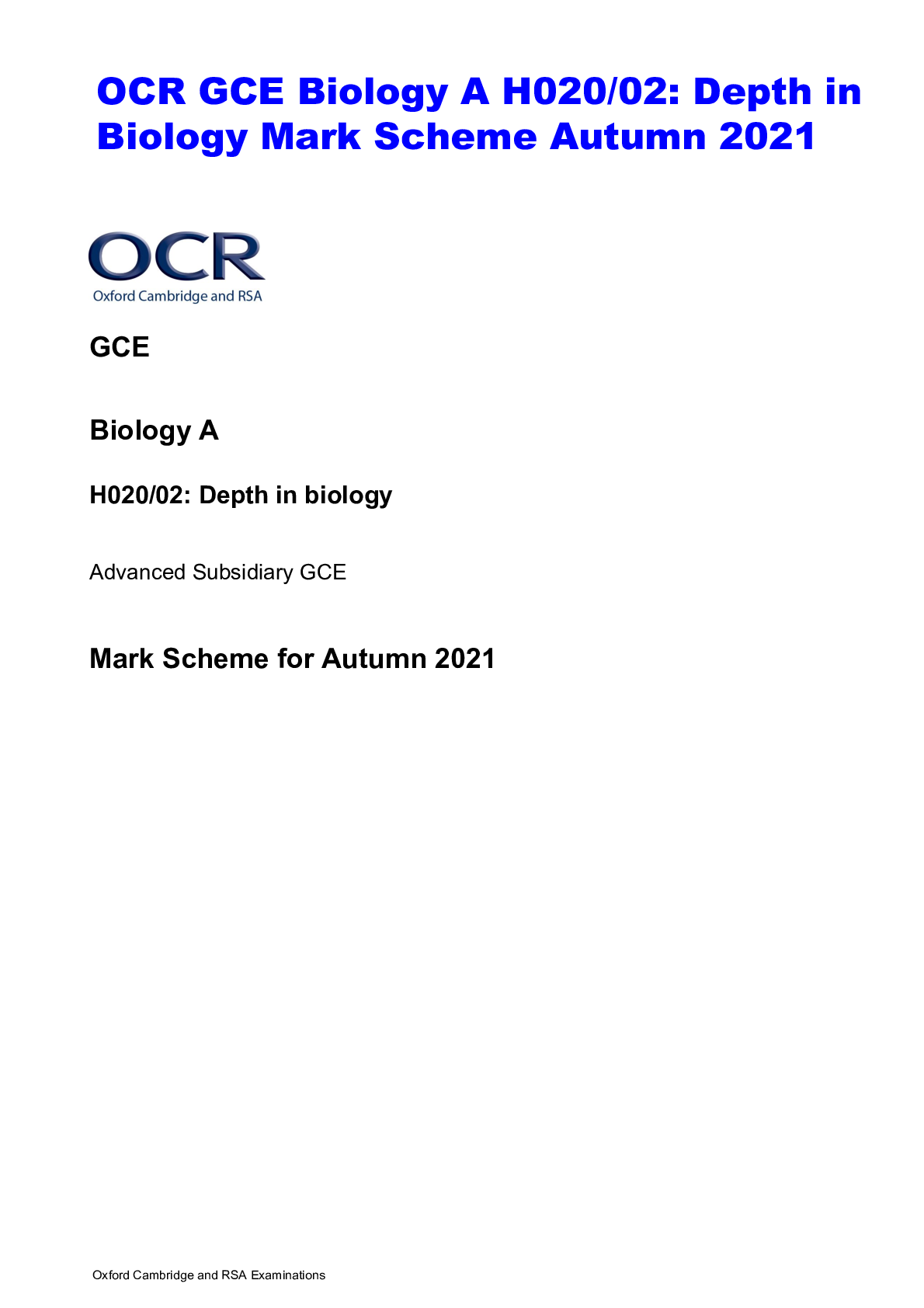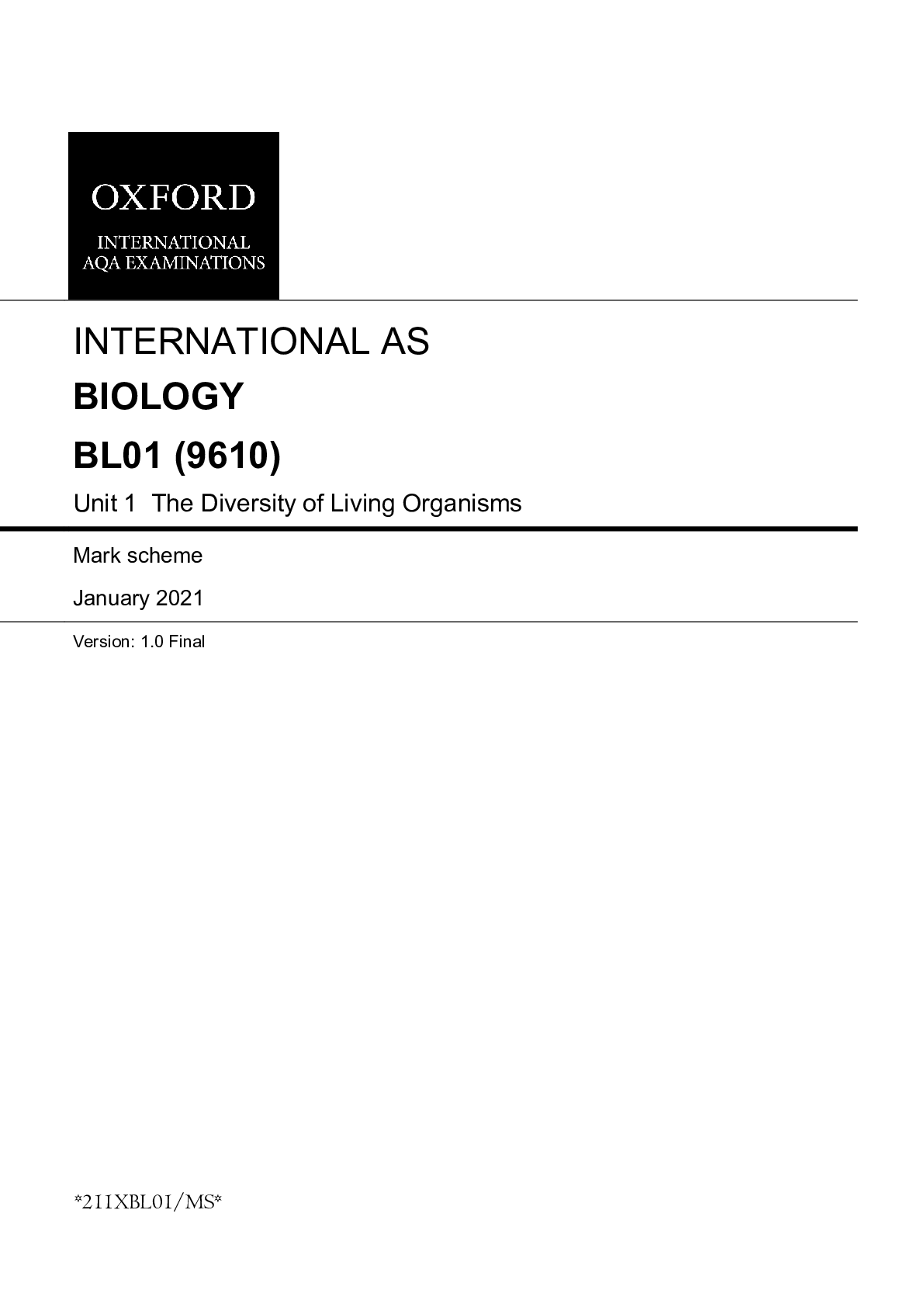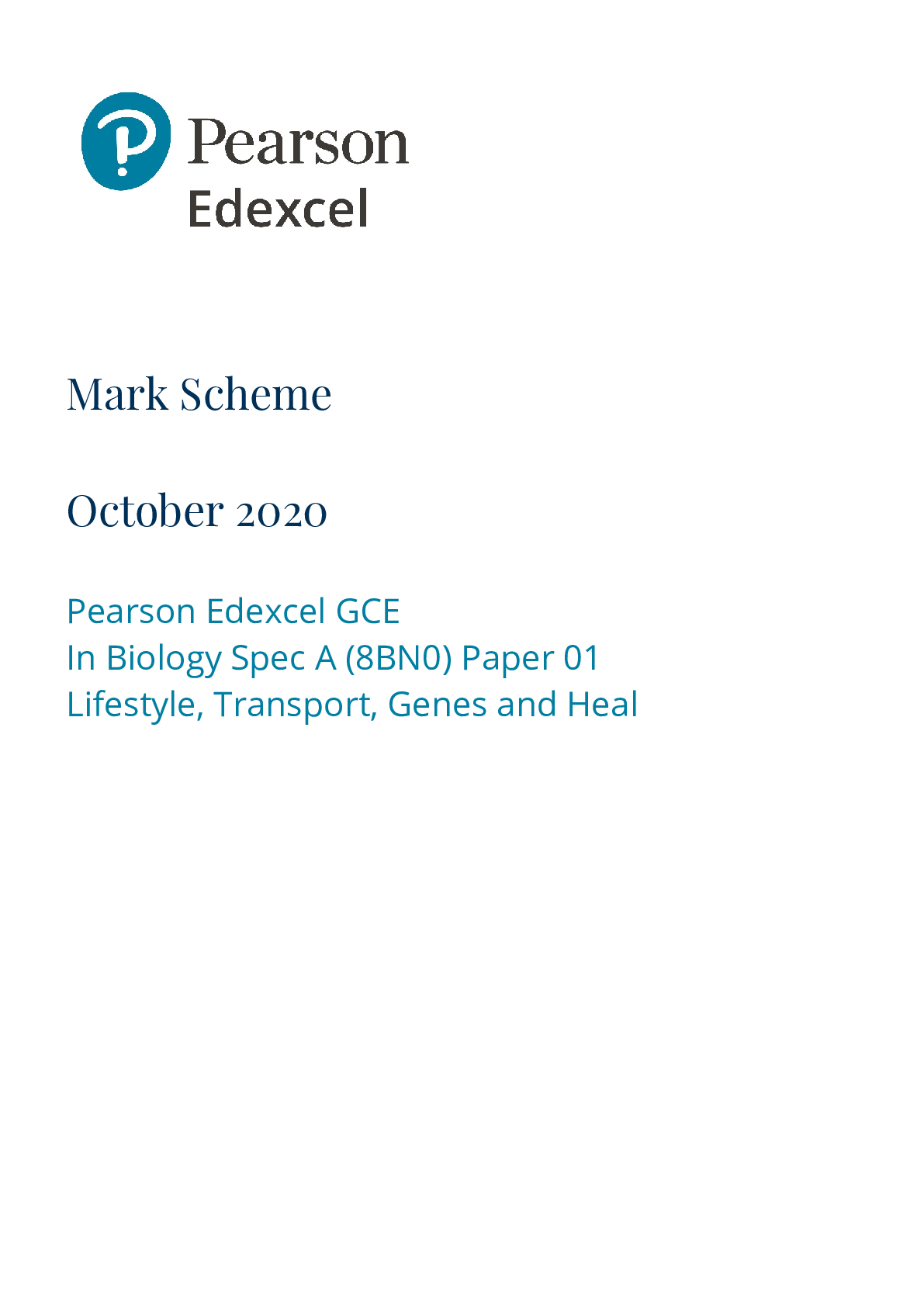English Language > AS Mark Scheme > GCE English Language H470/01: Exploring language Advanced GCE Mark Scheme for Autumn 2021 (All)
GCE English Language H470/01: Exploring language Advanced GCE Mark Scheme for Autumn 2021
Document Content and Description Below
Oxford Cambridge and RSA Examinations GCE English Language H470/01: Exploring language Advanced GCE Mark Scheme for Autumn 2021Oxford Cambridge and RSA Examinations OCR (Oxford Cambridge and RSA ... ) is a leading UK awarding body, providing a wide range of qualifications to meet the needs of candidates of all ages and abilities. OCR qualifications include AS/A Levels, Diplomas, GCSEs, Cambridge Nationals, Cambridge Technicals, Functional Skills, Key Skills, Entry Level qualifications, NVQs and vocational qualifications in areas such as IT, business, languages, teaching/training, administration and secretarial skills. It is also responsible for developing new specifications to meet national requirements and the needs of students and teachers. OCR is a not-for-profit organisation; any surplus made is invested back into the establishment to help towards the development of qualifications and support, which keep pace with the changing needs of today’s society. This mark scheme is published as an aid to teachers and students, to indicate the requirements of the examination. It shows the basis on which marks were awarded by examiners. It does not indicate the details of the discussions which took place at an examiners’ meeting before marking commenced. All examiners are instructed that alternative correct answers and unexpected approaches in candidates’ scripts must be given marks that fairly reflect the relevant knowledge and skills demonstrated. Mark schemes should be read in conjunction with the published question papers and the report on the examination. © OCR 2021H470/01 Mark Scheme October 2021 AnnotationsH470/01 Mark Scheme October 2021 PAPER-SPECIFIC INSTRUCTIONS: H470/01 Exploring language Candidates answer all the questions on the paper. The paper addresses all of the assessment objectives: Assessment Objectives AO1 and AO3 are addressed in question 1. Assessment Objectives AO2 and AO5 are addressed in question 2. Assessment Objectives AO1, AO3 and AO4 are addressed in question 3. In each question, the assessment objectives are given equal weighting. THE INDICATIVE CONTENT FOR EACH TASK provides an indication of what candidates are likely to cover. The notes are neither prescriptive nor exhaustive: candidates should be rewarded for any relevant response which appropriately addresses the Assessment Objectives. THE LEVEL DESCRIPTORS FOR EACH QUESTION FOLLOW THE INDICATIVE CONTENT. SUBJECT-SPECIFIC INSTRUCTIONS: ENGLISH LANGUAGE • Each level descriptor covers the relevant assessment objectives. • Where the assessment objectives appear in separate columns, marks should be allocated for each assessment objective independently of one another. There is no requirement for responses to be allocated marks from within the same level across each assessment objective. • An answer does not have to meet all the requirements of a level descriptor before being placed in that level. The extent to which it meets all of the requirements of a level descriptor will determine its placement within that level. • The extent to which the statements within the level have been achieved should be the only criteria used when deciding the mark within a level. • Indicative content indicates possible points candidates might make, but this is not an exhaustive account. Any valid response should be rewarded.H470/01 Mark Scheme October 2021 Indicative Content – Please note: indicative content indicates possible points candidates might make, but this is not an exhaustive account. Any valid response should be rewarded. Question Guidance Marks Text features 1 Text A is an extract from the introductory page of Lonely Planet’s guide to exploring Ireland written by the editor. It was published in 2017. Giving careful consideration to the context of the text: (a) Identify and analyse patterns of lexical and semantic use. (b) Identify and analyse the way sentences are constructed. Possibilities are provided below for guidance but any valid response should be rewarded. General contextual points (AO3): Candidates will bring to bear their knowledge of travel guides and the positive representation of Ireland which would be expected given the purpose of the text, which is to inform and encourage prospective tourists to visit the country. Candidates might also consider that the audience will be wide and mainstream and therefore an accessible register will be used. Contextually, Ireland is a popular holiday destination for UK tourists and students can comment where appropriate on the close relationship between the two countries and the positive stereotypical characteristics that are included in this opening. It is also worth noting that the register, although friendly and personable, is not directly attributed to anybody and is the result of a collection of editors’ comments. This is a legitimate consideration in any analysis of 20 In each of the bullet points below, AO1 is covered at the start of the point and AO3 at the end. (a) identify and analyse uses of lexis in this text. Possible features could be: • use of rhetorical tropes such as antistrophe/juxtaposition deliberately contrasting scale in opening sentence (‘A small country with a big reputation…’) to appeal to cultureconscious tourists with short breaks in mind • conversational register with second person pronouns (‘You’ll’) to emulate the words and wisdom of a confidante who the reader will trust when making big decisions such as travelling abroad • geographical Proper Nouns (‘Connemara’, ‘County Donegal’) which is expected given the genre of a travel guide to orientate the tourist • positive semantic field including adjectives such as ‘rich’, ‘warm’ and ‘breathtaking’ to sell the experience of Ireland • Irish lexis is used (‘tá fáilte romhat’) which is accompanied with phonetic spellings (‘taw fallcha row-at’) to assist the prospective tourist with understanding the English translation (‘You’re very welcome’) • metaphorical language is present through distinct verb choices (‘The Irish summer is awash with festivals’) to concisely promote the number and varietyH470/01 Mark Scheme October 2021 personal voice. The discourse structure of the text is important to address contextually with a mixture of graphological and structural features to guide the reader through appropriate subheadings and summaries. (b) identify and analyse the way sentences are constructed in this text. Possible features could be: • imperatives (‘Don’t think the Ireland of postcards…’) which mirrors spoken discourse with the editors advising their reader as they would a friend • syntax is broken with spoken asides (‘sunny’ of course being a relative term)’ to humour the UK reader in terms of what weather to expect • triadic listing as a rhetorical scheme with each clause beginning with a material verb (‘see a play…experience a traditional music ‘session’…attend a rock gig’) to showcase the many different activities available in Ireland • non-standard syntax is present through fronted conjunctions (‘And there’s history so young…But lest you think’) to portray the infinite number of possibilities and opportunities to tourists looking to holiday in the country • incongruity across clauses creates humour with a semantic contradiction (‘excess is encouraged, so long as it’s practised in moderation’)H470/01 Mark Scheme October 2021 There are a total of 20 marks available for Question 1. 10 marks can be awarded for part (a) and 10 marks for part (b). There is one mark per level for each AO. This table should be used twice – firstly to mark part (a) and allocate a mark out of 10, and then again to mark part (b) and allocate a mark out of 10. Parts (a) and (b) focus on different language levels, and therefore each part could achieve different language levels. Each part should be marked completely separately – there is no need to look for consistency in allocating marks if the responses demonstrate different levels of competency. Level AO1 and AO3 Mark 5 • Candidates clearly identify patterns of language use in precise relation to the linguistic level specified in the task and can closely analyse incisively chosen evidence, with application of appropriate terminology; the writing is in a secure academic register. (AO1) • With a precise hold on the language feature specified in the task, candidates perceptively evaluate the possible effect of contextual factors on the way language is produced in this text and is received and understood by its audience. (AO3) 9–10 4 • Candidates can single out and analyse relevant examples of language use related to the linguistic level specified in the task, with application of appropriate terminology and coherent written expression. (AO1) • Focusing on the language feature specified in the task, candidates can convincingly weigh up some possible effects of contextual factors on the way language is produced in this text and the way it is received and understood by its audience. (AO3) 7–8 3 • Candidates make some clear points about language use which relate to the specified language level and are supported with relevant evidence; use of terminology is mostly appropriate, although likely to be less densely packed than the level above and written expression is clear but likely not to be economical. (AO1) • Having a reasonable sense of the language feature specified, candidates come to some clear conclusions about the possible effect of contextual factors on the way language is produced in this text and is received by its audience. (AO3) 5–6 2 • Candidates attempt to make their writing relevant to the feature and language level specified in the task, pulling out the occasional piece of evidence and using terminology which is partially appropriate; written expression has some errors but the meaning is nonetheless apparent. (AO1) • Having some sense of the language feature specified, candidates come to some fairly loose conclusions about the possible effect of contextual factors on the way language is produced in this text and is received by its audience. (AO3) 3–4 1 • Candidates make some link to the specified feature and language level and some terms are used appropriately; evidence, if any, is likely to be barely relevant or only loosely defined (not actually quoted, for example) and writing may at times obscure meaning. (AO1) • Conclusions about the possible effect of contextual factors on the way language is produced and is received by the audience will be somewhat indistinct. There may be a vague sense of the text’s purpose. (AO3) 1–2 0 • No response or no response worthy of any credit. 0H470/01 Mark Scheme October 2021 Indicative Content – Please note: indicative content indicates possible points candidates might make, but this is not an exhaustive account. Any valid response should be rewarded. Question Guidance Marks Text features 2 ‘Changes in popular culture (one example is music) produce too much fresh terminology too quickly; it is impossible to keep up.' Write a speech to make to your English class, arguing either for or against the statement. You could focus on the example mentioned or on others. Your speech should contain a strong opening and clear argument. It should consider a range of views. It should be no more than 500 words. AO5 Candidates can begin their response with a strong opening taking a certain position on the topic e.g. whether they agree or disagree more with the statement. There could be a rebuttal of the opposing argument to ensure that candidates engage critically with the statement. It is expected that students will integrate a variety of spoken rhetorical strategies. In addition, it would be appropriate to include evidence in the form of facts/statistics and/or case studies to support specific arguments. Given the target audience of class peers around a similar age, it is expected that language would be tailored to this specific demographic. The content of the topical language issue is also age-appropriate so candidates should anticipate rebuttals that their peers would make in this particular context. 24 AO2 Whilst candidates can provide arguments in favour of the statement, to simply only agree with it will limit marks for this AO, due to not engaging critically (as per the question) with the concept of sociolinguistics and speech communities. In order to sufficiently demonstrate knowledge and understanding for this topical language issue, candidates must show an understanding of different spoken varieties and which varieties are spoken by certain age demographics. Students can also bring to bear their knowledge of how different popular culture (e.g. music) will appeal to certain age demographics and how these have an influence on the spoken varieties of these people. Candidates can take a critical angle on what they consider ‘popular culture to be.H470/01 Mark Scheme October 2021 Below are some areas that could be covered (e.g. music): • Role of Multicultural London English (MLE) in chart music – influential as a form of covert prestige in young speech communities • MLE’s origins as a shared form of language with different etymologies from India, the Caribbean and Africa used by music artists in rebellion to the established standard • Digitisation of the music industry online creating neologisms through a technological lexical field e.g. iTunes • Choreography in music dance videos coining new moves such as ‘the floss’ • Radio stations targeted to different demographics: BBC Radio 1 has a target audience of 15-30 and includes presenters who use terms associated with artists who top the chart; by contrast, BBC Radio 4 is targeted to middle class, middle-aged audiences with a large number of presenters who use RP regularly • Influence of Americanisms in pop music lexically, grammatically and phonetically • Music industry is a creative space and each artist will have different stories to tell through their songs; each artist will be of a different age and linguistic background/speech community so each may exhibit aspects of their idiolect through using unique lexis, grammar and pronunciationH470/01 Mark Scheme October 2021 There are a total of 24 marks available for Question 2. Decide on a mark for AO2 out of 12, and then a separate mark for AO5 out of 12. Add the two marks together to reach a total out of 24 marks. It is possible that candidates may achieve different levels for each AO: allocate the mark according to the level of competency demonstrated for each AO individually. Level AO2 Mark AO5 Mark 6 • In their piece of writing, candidates show an assured knowledge and understanding of the specified concept and issue and its relevance to language use. • Candidates engage critically with the specified concept and issue. 11–12 • An expertly-constructed text showing, perhaps surprising, originality in making the piece appropriate to the form specified in the task. • The use of appropriately chosen linguistic features shows flair and the writing precisely suits the audience defined in the task. 11–12 5 • In their piece of writing, candidates show a good knowledge and understanding of the specified concept and issue and its relevance to language use. • In their piece, candidates show that they can take a critical angle on the specified concept and issue. 9–10 • A well-constructed text, which is appropriate to the form specified in the task. • The use of appropriately chosen linguistic features shows skill and their writing suits the audience defined in the task. 9–10 4 • In their piece of writing, candidates show an essentially sound level of knowledge and understanding of the specified concept and issue and its relevance to language use. • Candidates show that they have some ability to think and write critically about the concept/issue. 7–8 • A deliberately constructed text, which contains most of the main elements of the form specified in the task. • There is clear use of appropriate linguistic features and the writing has been modulated to take account of the audience defined in the task. 7–8 3 • Their knowledge and understanding of the chosen language concept or issue is mostly accurate, although is likely to lack the depth needed to be convincing. • In their piece of writing, candidates have addressed the specified concept/issue, although not critically. 5–6 • A text which is attempting to match the task’s purpose and which is at least recognisable as an example of the form specified in the task. • There are some appropriate language features employed and some attempts have been made to take account of the audience defined in the task. 5–6 2 • Candidates’ knowledge and understanding of the concept/issue is likely to have inaccuracies or be muddled. • The language concept/issue is present in the piece although somewhat indistinct or confused. 3–4 • A text which has some sense of the form specified in the task, but which leaves out key elements. • There are some attempts to use appropriate language features, although probably not employing a register which suits the audience defined in the task. 3–4H470/01 Mark Scheme October 2021 Level AO2 Mark AO5 Mark 1 • Candidates do not appear to understand the concept or issue but it is possible to see one or two points relating to it. • The language concept or issue will be just barely detectable in the piece. 1–2 • Candidates produce writing which has little sense of the specified task, although there may be one or two superficial features of the form specified in the task. • One or two appropriate language features may be present; the audience is not understood or addressed. 1–2 0 • No response or no response worthy of any credit. 0 • No response or no response worthy of any credit. 0H470/01 Mark Scheme October 2021 Indicative Content – Please note: indicative content indicates possible points candidates might make, but this is not an exhaustive account. Any valid response should be rewarded. Question Guidance Mark Text features 3 Using appropriate linguistic concepts and methods, analyse the ways in which language is used in these two texts. In your answer you should: • explore connections and variations between the texts • consider how contextual factors contribute to the construction of meaning. AO3 Both texts share the same subject of Love Island, a popular reality television programme that airs on ITV2. Text B is a transcript of a recording of the show in 2019 36 Phonetics, phonology and prosodics Text B Text C • Emphatic stress is used by the voiceover to introduce this particular segment of the show (‘Danny’s’) functioning as a discourse marker • Use of non-standard backchannelling through pragmatic intonation from Yewande (‘mmhmm’) • Standard English is used throughout with no attempt at phonetic spellings.H470/01 Mark Scheme October 2021 whilst Text C is a review of the programme in 2017 published by Vogue online. The reality television programme is very popular with teenagers and young adults due to the influence that contestants have during and after entering the show on social media. Candidates are likely to have at least some contextual knowledge of its format. Text B is an extract of a discussion had by two contestants on the show who are trying to ascertain whether there is romantic chemistry between them. Candidates can analyse the artificial contexts that the contestants are in when trying to ‘couple-up’ and the financial reward which may be the driving force for winning the show. Text C takes a critical angle to the programme, despite the focus on fashion and image on both Love Island and in Vogue. The use of personal power in the title ‘psychologists’ conveys the educational/moral authority that they have when commenting on the impacts of the programme. Vogue, due to its high-quality and prestigious Lexis and semantics Text B Text C • Non-fluency features are present consistently throughout the text with fillers (‘umm’), overlapping speech and latching on typical of spontaneous, natural dialogue • Very high frequency lexis is used with lexical repetition (‘thinking’) although interesting use of the term (‘feedback’) which is more commonly found in educational rather than romantic contexts • Collocation from voiceover (‘cool as a cucumber’) and use of antithesis to contrast emotional state using material verbs (‘dropped’, ‘smashed’) • Taboo lexis as part of Danny’s idiolect (‘oh my God’) functioning as a hyperbolic discourse marker • Low frequency, polysyllabic terms used (‘platonic’, ‘contrived’, ‘inescapable’) indicates the more educated, middle class audience that would be reading this review • Mythological Greek references (‘panacea’) and Italianate terms (‘braggadocio’) used by quoted psychologists as part of academic register illustrating personal and social power • Mixed register is present in producer’s opinion writing using spoken asides to the audience (‘think Big Brother but on the beach) to provide humour including sexual references (‘not to mention what goes on under the sheets’) • Titles used for personal power (‘Associate Digital Editor’, ‘clinical director’)H470/01 Mark Scheme October 2021 position in the fashion industry, is more likely to be read by a slightly older, female audience with more disposable capital than the younger, more mixed audience who would watch Love Island. Both texts have a primary purpose to entertain with the programme being the most-watched show on ITV2 whilst Text C is an opinion piece from a senior figure within Vogue. AO4 Candidates can apply their knowledge of conversation analysis to Text B. They may consider how the programme has been recorded and although is very close to spontaneous conversation, the show is edited for an external audience. The role of the voiceover also provides scope for analysis, explicitly indicating the entertainment value of the show. Students can also apply their knowledge of spoken power and politeness strategies which are used by both participants. Grammar and morphology Text B Text C • Multiple interrogatives are used by both participants in order to establish their connection (‘what are you thinking?’) • Danny uses present continuous (‘I’m thinking I’m really liking’) rather than simple present which could be a feature of his variety or syntactic mirroring of Yewande’s interrogative including present continuous • Non-standard syntax present with Danny using was/were variation and the nonstandard inflected form (‘you wasn’t’) and past tense variation (‘I’ve just spoke’) • Elision of adjectival phrase (‘s’lucky’) merging the intensifier with the adjective • Anaphora used for emphasis (‘I feel like we’re both…I feel like we’re both’) with the use of inclusive first person plural pronouns to encourage united thinking • Use of interrogatives by the producer of the text in title (‘What do psychologists make of it?’) to frame the text as well as to introduce contributors (‘So what are the psychological impacts?’) • Non-standard syntax with fronted conjunctions (‘But behind the fun’) to introduce a new but related point • Rhetorical schemes such as enumeratio are present when listing the negative processes of the show contrasting with a final positive (‘contestants are judged…subject to scrutiny and criticism…thrown into platonic and romantic relationships…in the name of good TV’) • Colloquial verb phrases from psychologists contrast academic register with inclusive pronouns (‘can see us knocked out for ages’) Pragmatics Text B Text C • Lots of overlapping speech and latching on by both participants conveying anxiety and apprehension about each others’ thought processes • Use of hedges by Yewande to mitigate a face-threatening act (‘I know Holly does kind of fancy you’) • Deliberate non-standard syntax (‘I don’t play no games’) from Danny to alleviate tension regarding possible other romantic encounters • Humour present through use of abstract noun with life-threatening situations (‘survival’) used in the context of a romantic reality television show • Many asides are provided by the producer to indicate position within the debate (‘they all have the physiques of personal trainers, which is what most of them are’) – these are also coupled with those from the psychologists (‘of course it never quite works like that in the end’)H470/01 Mark Scheme October 2021 For Text C, the mode is mixed rather than spoken and candidates should be able to provide a focussed analysis on this aspect of the comparison. More polysyllabic, low frequency terms are used; academic registers are employed when quoting the psychologists; and there are Greek mythological references. There is still evidence, however, of a conversational tone. Discourse Text B Text C • Use of quotative ‘like’ by Danny in order to represent reported speech (‘and I’m like oh my God’) as well as using ‘like’ as a discourse particle (‘how do you think of Yewande like’) • Overlapping speech and latching on is generally very constructive with backchannelling, particularly by Yewande (//yep//, //exactly//) • Discourse structure of the segment is precise with a humorous opening from the voiceover, the conversation between the two participants unfolding and then a piece to camera by Yewande at the end • Purposeful, tight discourse structure starting with an opening interrogative in the title before a section by the producer outlining the context of the programme before two contributing psychologists comment with their opinions • Register notably changes from being chatty and conversational in producer’s opening paragraph to the more academic remarks of the psychologists – there are moments, however, when the psychologists do use colloquial phrases (‘take it on the chin’) • Hyperlinks are provided (‘Harley Therapy’) due to it being an online article signposting receivers to a different webpage for further information as a form of publicityH470/01 Mark Scheme October 2021 There are a total of 36 marks available for Question 3. Decide on a mark for AO1 out of 12, and then a separate mark for AO3 out of 12, and a separate mark for AO4 out of 12. Add the three marks together to reach a total out of 36 marks. It is possible that candidates may achieve different levels for each AO: allocate the mark according to the level of competency demonstrated for each AO individually. Level AO1 Mark AO3 Mark AO4 Mark 6 • Candidates apply a range of appropriate methods in an assured and systematic way, using appropriate terminology and writing in a secure academic register. • They deftly establish and explore patterns of language use and can closely analyse incisively chosen evidence. 11–12 • Candidates make discerning points about the possible effect of contextual factors on particular features of language, both in terms of production and reception. • They perceptively evaluate their points, suggesting alternatives for how context might account for variations in language use. 11–12 • Candidates selectively and methodically apply confident knowledge of appropriate linguistic concepts across both texts. • Candidates compare particular linguistic features in the two texts, making illuminating connections between them which clearly establish some of the varied ways that language is used. 11–12 5 • Candidates apply a range of appropriate methods to the texts in a systematic way, using appropriate terminology and coherent written expression. • They establish patterns of language use and can analyse well-chosen evidence in some depth. 9–10 • Candidates make strong and helpful points about relevant contextual factors, showing how context might affect language use, both in terms of production and reception. • They show that they can weigh up how contextual factors might account for variations in language use. 9–10 • Candidates methodically apply sound knowledge of appropriate linguistic concepts across both texts. • Candidates compare linguistic features in the two texts, making helpful connections between them which show some of the ways that language varies. 9–10H470/01 Mark Scheme October 2021 Level AO1 Mark AO3 Mark AO4 Mark 4 • Candidates apply some appropriate methods in a sound way, using mostly appropriate terminology and coherent if uneconomical writing. • Analysis is characterised by either a fairly limited number of well-developed points, with relevant evidence, or a larger number of valid supported points that lack depth. 7–8 • Candidates make some valid points about context, showing how contextual factors can affect language production and reception. • They come to some sound conclusions about how contextual factors could cause variations in language. 7–8 • Candidates apply accurate knowledge of linguistic concepts to language features in a way that is mostly appropriate, across both texts. • They make some comparisons of linguistic features in the two texts, making some connections between them which show ways in which language use varies. 7–8 3 • Candidates attempt to apply linguistic methods with some success, and terminology is at times appropriate; written expression contains some errors. • Analysis is uneven and is characterised by either scattered points that are supported with evidence or points which may have validity but are unsupported. 5–6 • Candidates make a few successful attempts at showing how basic contextual factors affect the way language is produced and received. • Conclusions drawn tend to be assertive and simplistic rather than weighed in the balance and are sometimes unconvincing; there may be an elementary sense of how context affects language variation. 5–6 • Candidates have a loose grasp of linguistic concepts and attempt to apply them to both texts, although sometimes unconvincingly. • They will make more general connections and will attempt to compare particular features but with only partial success. 5–6H470/01 Mark Scheme October 2021 Level AO1 Mark AO3 Mark AO4 Mark 2 • Candidates make a vague attempt to apply linguistic methods to the texts and some terms are used, with occasional appropriateness; writing is likely to contain errors which sometimes obscures meaning. • One or two simple points are made, with little or tenuous evidence; assertive rather than analytical. 3–4 • Candidates can comment on context, although this is unlikely to show proper grasp of production and reception and so is of very limited use. • Evaluation of points is not happening in this level because there is no real exploration of language, but there may be one or two generalisations made about the effects of context on the language. 3–4 • Where linguistic concepts are in evidence for each text, understanding is shallow and knowledge of them is likely to be muddled. • Some loose connections between the texts are established in one or two places in the answer. These connections are likely to be simple matching and contrasting of features with very little demonstration of how language varies. 3–4 1 • Candidates struggle to apply the linguistic methods; terminology, if present, is inappropriate and accuracy of written expression is very limited. • There may be the odd point made but there is no analysis with evidence. 1–2 • One or at the most two references are made to the context with no link to language production or reception. • Little or no attempt to draw conclusions about the effect of context on different uses of language. 1–2 • Any knowledge of linguistic concepts is likely to be mostly inaccurate with perhaps a very vague sense of understanding both texts being present. • The notion of comparison is essentially lost in this level. There may be one or two connections here and there but these do not help with notions of the varieties of language use. 1–2 0 • No response or no response worthy of any credit. 0 • No response or no response worthy of any credit. 0 • No response or no response worthy of any credit. 0OCR (Oxford Cambridge and RSA Examinations) The Triangle Building Shaftesbury Road Cambridge CB2 8EA [Show More]
Last updated: 3 years ago
Preview 1 out of 19 pages

Buy this document to get the full access instantly
Instant Download Access after purchase
Buy NowInstant download
We Accept:

Reviews( 0 )
$7.50
Can't find what you want? Try our AI powered Search
Document information
Connected school, study & course
About the document
Uploaded On
Oct 10, 2022
Number of pages
19
Written in
All
Additional information
This document has been written for:
Uploaded
Oct 10, 2022
Downloads
0
Views
106













